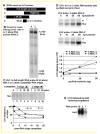Differences in fat and muscle mass associated with a functional human polymorphism in a post-transcriptional BMP2 gene regulatory element
- PMID: 19492344
- PMCID: PMC4147943
- DOI: 10.1002/jcb.22209
Differences in fat and muscle mass associated with a functional human polymorphism in a post-transcriptional BMP2 gene regulatory element
Abstract
A classic morphogen, bone morphogenetic protein 2 (BMP2) regulates the differentiation of pluripotent mesenchymal cells. High BMP2 levels promote osteogenesis or chondrogenesis and low levels promote adipogenesis. BMP2 inhibits myogenesis. Thus, BMP2 synthesis is tightly controlled. Several hundred nucleotides within the 3' untranslated regions of BMP2 genes are conserved from mammals to fishes indicating that the region is under stringent selective pressure. Our analyses indicate that this region controls BMP2 synthesis by post-transcriptional mechanisms. A common A to C single nucleotide polymorphism (SNP) in the BMP2 gene (rs15705, +A1123C) disrupts a putative post-transcriptional regulatory motif within the human ultra-conserved sequence. In vitro studies indicate that RNAs bearing the A or C alleles have different protein binding characteristics in extracts from mesenchymal cells. Reporter genes with the C allele of the ultra-conserved sequence were differentially expressed in mesenchymal cells. Finally, we analyzed MRI data from the upper arm of 517 healthy individuals aged 18-41 years. Individuals with the C/C genotype were associated with lower baseline subcutaneous fat volumes (P = 0.0030) and an increased gain in skeletal muscle volume (P = 0.0060) following resistance training in a cohort of young males. The rs15705 SNP explained 2-4% of inter-individual variability in the measured parameters. The rs15705 variant is one of the first genetic markers that may be exploited to facilitate early diagnosis, treatment, and/or prevention of diseases associated with poor fitness. Furthermore, understanding the mechanisms by which regulatory polymorphisms influence BMP2 synthesis will reveal novel pharmaceutical targets for these disabling conditions.
(c) 2009 Wiley-Liss, Inc.
Figures



Similar articles
-
A polymorphism in a conserved posttranscriptional regulatory motif alters bone morphogenetic protein 2 (BMP2) RNA:protein interactions.Mol Endocrinol. 2006 Jul;20(7):1574-86. doi: 10.1210/me.2005-0469. Epub 2006 Feb 23. Mol Endocrinol. 2006. PMID: 16497730
-
A conserved post-transcriptional BMP2 switch in lung cells.J Cell Biochem. 2010 May 15;110(2):509-21. doi: 10.1002/jcb.22567. J Cell Biochem. 2010. PMID: 20432245
-
Turning Bone Morphogenetic Protein 2 (BMP2) on and off in Mesenchymal Cells.J Cell Biochem. 2015 Oct;116(10):2127-38. doi: 10.1002/jcb.25164. J Cell Biochem. 2015. PMID: 25776852 Free PMC article. Review.
-
An autonomous BMP2 regulatory element in mesenchymal cells.J Cell Biochem. 2011 Feb;112(2):666-74. doi: 10.1002/jcb.22975. J Cell Biochem. 2011. PMID: 21268088 Free PMC article.
-
Characterization of new bone morphogenetic protein (Bmp)-2 regulatory alleles.Genesis. 2017 Jul;55(7):10.1002/dvg.23035. doi: 10.1002/dvg.23035. Epub 2017 May 22. Genesis. 2017. PMID: 28401685 Free PMC article.
Cited by
-
Large meta-analysis of genome-wide association studies identifies five loci for lean body mass.Nat Commun. 2017 Jul 19;8(1):80. doi: 10.1038/s41467-017-00031-7. Nat Commun. 2017. PMID: 28724990 Free PMC article.
-
Genetic Variants of BMP2 and Their Association with the Risk of Non-Syndromic Tooth Agenesis.PLoS One. 2016 Jun 30;11(6):e0158273. doi: 10.1371/journal.pone.0158273. eCollection 2016. PLoS One. 2016. PMID: 27362534 Free PMC article.
-
Integrated analysis of genome-wide association studies and 3D epigenomic characteristics reveal the BMP2 gene regulating loin muscle depth in Yorkshire pigs.PLoS Genet. 2023 Jun 20;19(6):e1010820. doi: 10.1371/journal.pgen.1010820. eCollection 2023 Jun. PLoS Genet. 2023. PMID: 37339141 Free PMC article.
-
An in vivo map of bone morphogenetic protein 2 post-transcriptional repression in the heart.Genesis. 2011 Nov;49(11):841-50. doi: 10.1002/dvg.20757. Epub 2011 Oct 14. Genesis. 2011. PMID: 21504044 Free PMC article.
-
Competing Repressive Factors Control Bone Morphogenetic Protein 2 (BMP2) in Mesenchymal Cells.J Cell Biochem. 2016 Feb;117(2):439-47. doi: 10.1002/jcb.25290. J Cell Biochem. 2016. PMID: 26212702 Free PMC article.
References
-
- Abrams KL, Xu J, Nativelle-Serpentini C, Dabirshahsahebi S, Rogers MB. An evolutionary and molecular analysis of Bmp2 expression. J Biol Chem. 2004;279:15916–15928. - PubMed
-
- Ausubel FM, Brent R, Kingston RE, Moore DD, Seidman JG, Smith JA, Struhl K. Current protocols in molecular biology. NY: Wiley and Sons; 1997.
-
- Balint E, Lapointe D, Drissi H, van der Meijden C, Young DW, van Wijnen AJ, Stein JL, Stein GS, Lian JB. Phenotype discovery by gene expression profiling: Mapping of biological processes linked to BMP-2-mediated osteoblast differentiation. J Cell Biochem. 2003;89:401–426. - PubMed
-
- Cheng SL, Shao JS, Charlton-Kachigian N, Loewy AP, Towler DA. MSX2 promotes osteogenesis and suppresses adipogenic differentiation of multipotent mesenchymal progenitors. J Biol Chem. 2003;278:45969–45977. - PubMed
-
- Conne B, Stutz A, Vassalli JD. The 3′ untranslated region of messenger RNA: A molecular ‘hotspot’ for pathology? Nat Med. 2000;6:637–641. - PubMed
Publication types
MeSH terms
Substances
Grants and funding
LinkOut - more resources
Full Text Sources

